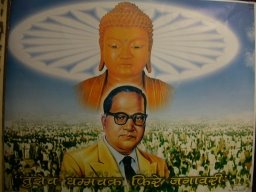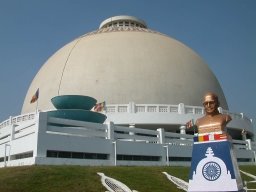Celebration of the Anniversary of Dr. Ambedkar's conversion - and new conversions in Nagpur
 Vishvapani reports from Nagpur on the eve of Dr. Ambedkar's 50th anniversary to Buddhism.
Vishvapani reports from Nagpur on the eve of Dr. Ambedkar's 50th anniversary to Buddhism. For the few days before the big event in Nagpur, I have been attending a conference for Buddhists from around the world at Nagaloka, a large and well-equipped centre on the outskirts of Nagpur. 150 monks, activists, Ambedkarites and other Buddhists have gathered in advance of the diksa (conversion) on Monday. It is a little incongruous to be in such secluded surroundings while there is such ferment around us, but the event is a powerful convergence of ideas on the relevance of Buddhism to society in India, East Asia and the West. Attendees included Christopher Queen of Harvard University - the leading western scholar of the Ambedkarite movement.
The keynote talk was by Subhuti, a leading member of the Western Buddhist Order who argued that Dr Ambedkar, the great dalit politician activist and thinker who started the conversion movement 50 years ago, is an important figure for all Buddhists who has made a unique contribution to the tradition. He declared: ‘I now consider myself a follower of Dr Ambedkar.’
 Today in Nagpur Diksabhumi – the vast piece of land in the center of the city where Dr Ambedkar adopted Buddhism with millions of his followers in 1956 – was thronged with millions of dalit and other Buddhists as well as representatives of other communities involved in the new wave of conversions that is taking place across India over the next few weeks. I watched as a great incessant stream of people flooded into the ground all day long – while another stream headed in the other direction. When the numbers involved are so vast one can only guess at their true extent, but conservative estimates before the event were that a million people would attend, more likely two million, and there may well have been many more.
Today in Nagpur Diksabhumi – the vast piece of land in the center of the city where Dr Ambedkar adopted Buddhism with millions of his followers in 1956 – was thronged with millions of dalit and other Buddhists as well as representatives of other communities involved in the new wave of conversions that is taking place across India over the next few weeks. I watched as a great incessant stream of people flooded into the ground all day long – while another stream headed in the other direction. When the numbers involved are so vast one can only guess at their true extent, but conservative estimates before the event were that a million people would attend, more likely two million, and there may well have been many more.Standing in the huge crowd, looking down on it from a neighbouring building, and joining the throng that processed through the stupa – or huge temple – that dominates the site, I was deeply moved by the power of the occasion. Many of those attending had walked for days or traveled across India to be there; their faces as they entered the stupa were intent, serious and filled with devotion for their revered hero, Dr Ambedkar; and there was a palpable sense that history was being made. For the last fifty years since Dr Ambedkar converted himself the movement he started has been dominated by people born into the Maharashtra dalit sub-caste, the Mahars. Now the movement is being embraced by large numbers from other caste backgrounds and from across India. A number of conversion ceremonies took place today that included representatives of such communities: these were the first steps in a wave of conversions that will be taking place over the next few weeks.
This morning several hundred members of the tribal communities led by the writer, Lakshman Mane, embraced Buddhism in a ceremony at Dhiksabhumi. Mane’s followers number in the millions and in the coming weeks there will be at least half-a-million further conversions from this group, and up to five or six million. I will be meeting Laksman Mane tomorrow and will have more information as well as comment by him in tomorrow’s blog.
The tribals have a similar status under the Hindu caste system to those considered ‘untouchable’, now referred to as Dalits. Across India there are around 50 million tribals and this is the first large-scale mass conversion of tribals to Buddhism.
In a ceremony this morning at Nagaloka, the center on the Nagur outskirts where I have been staying, 200 men and women from Tamil-Nadu became Buddhists in a ceremony led by Dhammachari Vivekaratna. They had traveled across India to attend, and will return to initiate the conversions of tens of thousands of others in their native state. They are led by a remarkable woman called P. Lalida who I will be meeting in the next few days – I’ll post a report.
Also this morning, Dhammachari Subhuti conducted a ceremony in Nagpur for 50 representatives of the Matang sub-caste. This community accounts for many of the non-Mahar Dalits in Maharashtra. Over the next six weeks there will be conversion ceremonies for 50,000 Matangs across the central Indian state.
For those interested in following events more closely, check Vishvapani's blog of the occasion - http://www.ambedkar2006.blogspot.com/
Labels: India

 rss
rss
0 Comments:
Post a Comment
<< Home